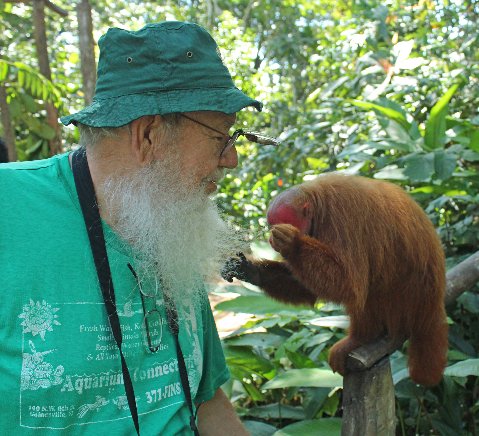One of the turtle species that Ron and I encountered on the Colima trip was a semi-aquatic creature of primarily terrestrial habits. Known as the Mexican spotted wood turtle, the subspecies we happened across was
Rhinoclemmys rubida perixantha, the more northerly of the 2 known forms.

We encountered 3 of this (as we later learned) uncommon little chelonian. All of these little brown turtles seen were active at night in a flooded field just east of the city of Colima.
The most conspicuous things about these turtles were the intricate and busy head patterns of broad, dark edged, yellow bars and spots. Although the yellow head patterns precluded
R. rubida being mistaken for
R. pulcherrima, at 6 to 8 inches in length the former were also of smaller size.
Very little is yet known about the diet of the Mexican spotted wood turtle. It is thought that like others in the genus the species eats a good amount of vegetable matter and is an opportunist feeder on invertebrates. It is known that captives relish worms, caterpillars, and land dwelling molluscs.
Hopefully, as the Behler Center works with their group we will learn more about this beautiful and delightful turtle.
Note the intricate head pattern of this beautiful turtle.

This is the plastron of a Mexican spotted wood turtle.

 Author, photographer, and columnist Richard Bartlett is one of the most prolific writers on herpetological subjects in the 20th century. With hundreds of books and articles to their credit, Richard and his wife Pat have spent over four decades documenting reptiles both in the field and in captivity. For a list of their current titles, please visit their page in our bookstore. Author, photographer, and columnist Richard Bartlett is one of the most prolific writers on herpetological subjects in the 20th century. With hundreds of books and articles to their credit, Richard and his wife Pat have spent over four decades documenting reptiles both in the field and in captivity. For a list of their current titles, please visit their page in our bookstore. |




To prevent automated Bots from commentspamming, please enter the string you see in the image below in the appropriate input box. Your comment will only be submitted if the strings match. Please ensure that your browser supports and accepts cookies, or your comment cannot be verified correctly.